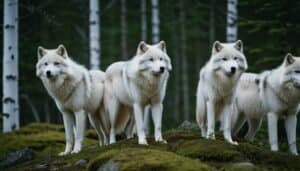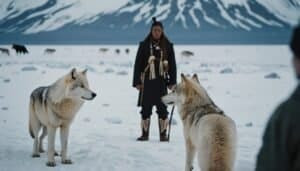Introduction
Understanding how traditional ecological knowledge (TEK) contributes to Arctic wolf conservation requires examining the role of indigenous communities and their practices. TEK, passed down through generations, encompasses a deep understanding of local ecosystems and species
This article explores the definition and importance of TEK, highlights the role of indigenous knowledge in conservation efforts, examines specific TEK practices in monitoring Arctic wolf populations, discusses habitat preservation methods, and considers the integration of TEK with modern science
Additionally, it addresses policy support for TEK and provides recommendations for enhancing its utilization in Arctic wolf conservation strategies
Understanding Traditional Ecological Knowledge
Traditional Ecological Knowledge (TEK) is a cumulative body of knowledge, practices, and beliefs that is handed down through generations by cultural transmission. It encompasses a deep understanding of the relationships between living beings, including humans, and their environment
TEK is rooted in the long-term observations and experiences of indigenous peoples, making it invaluable for understanding and managing local ecosystems, including those of Arctic wolves
Definition and Importance of TEK
TEK is more than just information about the natural world; it is a comprehensive system that integrates ecological, cultural, and spiritual knowledge
According to the United Nations Educational, Scientific and Cultural Organization (UNESCO), TEK includes “local and indigenous ways of knowing which have evolved over millennia through direct contact with the environment”. This knowledge is dynamic and continually adapted based on new observations and changing environmental conditions
One of the key strengths of TEK is its holistic perspective. It does not separate humans from nature but views them as part of an interconnected system
This holistic approach is crucial for conservation because it considers not only the biological aspects of species and habitats but also the cultural and spiritual dimensions that influence how ecosystems are managed
TEK’s importance in conservation lies in its depth of local knowledge, which often exceeds that of scientific studies conducted over shorter time spans. For example, indigenous communities in the Arctic have detailed knowledge of wolf behavior, migration patterns, and population dynamics, information that is crucial for effective conservation strategies
Differences Between TEK and Scientific Knowledge
While TEK and scientific knowledge both seek to understand and manage the natural world, they differ in several fundamental ways. Scientific knowledge is typically generated through systematic observation, experimentation, and analysis, often with a focus on generalizability and replication
In contrast, TEK is derived from long-term, place-based observations and is passed down orally through generations
One of the main differences lies in the methods of validation. Scientific knowledge relies on peer review and experimental reproducibility, while TEK is validated through practical application and the test of time
TEK’s accuracy and reliability are proven through its continued use in managing local resources and ecosystems effectively over centuries
Moreover, TEK often includes qualitative information and is deeply embedded in the cultural and spiritual context of the community. For instance, TEK may involve stories, songs, and rituals that encode ecological knowledge, making it accessible and meaningful to community members
This cultural embedding can foster a strong conservation ethic, as the health of the ecosystem is tied to the community’s identity and well-being
Contributions of Indigenous Knowledge
Indigenous communities play a crucial role in Arctic wolf conservation through the application of TEK. Their knowledge contributes to various aspects of conservation, from population monitoring to habitat management
Indigenous hunters and trappers, for example, possess detailed understanding of wolf territories, prey availability, and seasonal movements, which can complement scientific data and fill gaps in research
TEK also emphasizes sustainable resource use, ensuring that conservation practices do not deplete resources but instead promote the long-term health of the ecosystem. This sustainable approach is vital for the preservation of Arctic wolves, whose survival depends on the availability of prey and suitable habitats
Examples of Indigenous Conservation Practices
Several specific TEK practices have been instrumental in Arctic wolf conservation. These include:
Monitoring and Reporting: Indigenous communities often engage in regular monitoring of wolf populations and report changes to conservation authorities. This local surveillance can provide early warnings of population declines or threats
Habitat Management: Indigenous knowledge of the land can guide habitat management practices, such as controlled burns or the protection of critical breeding areas, ensuring that wolves have access to the resources they need to thrive
Cultural Rituals and Norms: Many indigenous cultures have rituals and norms that promote respect for wolves and their habitats. These cultural practices can serve as informal conservation measures, reducing human-wolf conflicts and fostering coexistence
Collaborative Research: Indigenous communities are increasingly partnering with scientists to conduct research that combines TEK and scientific methods. These collaborations can enhance the understanding of wolf ecology and improve conservation outcomes
Role of Indigenous Communities in Arctic Wolf Conservation
Indigenous communities are central to the conservation of Arctic wolves, utilizing their Traditional Ecological Knowledge (TEK) to manage and protect these majestic animals
This section delves into the contributions of indigenous knowledge and practices to Arctic wolf conservation, emphasizing the practical and cultural aspects that support sustainable coexistence
Contributions of Indigenous Knowledge
Indigenous communities, with their deep-rooted connection to the land, possess a wealth of knowledge that is crucial for the conservation of Arctic wolves
Their contributions can be seen in several key areas:
In-Depth Understanding of Ecosystems: Indigenous peoples have an intimate understanding of their local ecosystems, which includes knowledge of wolf behavior, prey species, and environmental changes
This understanding is often more nuanced and detailed than that obtained through short-term scientific studies. For example, the Inuit have extensive knowledge of caribou migration patterns, which are closely linked to the movements and hunting behaviors of Arctic wolves
Long-Term Observations: TEK is based on centuries of observation and experience, providing a long-term perspective on environmental changes and species interactions. This historical insight is invaluable for detecting trends and changes in wolf populations that may not be apparent from short-term scientific data
Adaptive Management Practices: Indigenous communities use adaptive management practices that are responsive to environmental changes
These practices ensure the sustainability of both the wolves and their prey, helping to maintain a balanced ecosystem. For instance, indigenous hunting practices are often regulated by traditional laws and customs that prevent overharvesting and ensure the continued availability of prey for wolves
Examples of Indigenous Conservation Practices
Indigenous conservation practices are diverse and tailored to the specific needs of the Arctic environment and its inhabitants
Here are some notable examples:
Community-Based Monitoring: Indigenous communities often engage in community-based monitoring of wildlife populations
This involves local hunters, trappers, and elders observing and recording wolf sightings, tracks, and signs, providing real-time data on wolf presence and behavior. Such monitoring programs have been successful in regions like the Canadian Arctic, where Inuit hunters collaborate with scientists to track wolf populations and health
Habitat Protection and Restoration: Indigenous knowledge guides habitat protection and restoration efforts. For example, the preservation of den sites and critical hunting areas ensures that wolves have safe places to raise their young and sufficient prey to sustain their populations
In Alaska, the Gwich’in people have long advocated for the protection of the Arctic National Wildlife Refuge, recognizing its importance for both caribou and wolves
Cultural Practices and Norms: Indigenous cultures often have spiritual beliefs and practices that promote the respect and protection of wolves
These cultural norms can serve as informal conservation measures. Among the Inuit, there are traditional stories and taboos that emphasize the importance of treating wolves with respect, discouraging unnecessary killing and promoting coexistence
Participatory Research: Indigenous communities are increasingly involved in participatory research projects that combine TEK with scientific methods
These collaborations help to bridge the gap between traditional and scientific knowledge, enhancing the overall understanding of wolf ecology and informing more effective conservation strategies. For example, in the Northwest Territories, Dene and Métis communities work with researchers to study the impacts of climate change on wolf-prey dynamics
Examples of Indigenous Conservation Practices
Indigenous conservation practices are deeply integrated into their cultural and social systems, providing practical and ethical guidelines for interacting with wildlife
These practices are not only effective in conserving Arctic wolves but also in promoting broader environmental stewardship:
Sustainable Hunting Practices: Indigenous hunters often follow traditional laws that limit the number of animals taken and ensure that hunting practices do not harm the overall health of wildlife populations. This sustainable approach helps maintain the balance between predator and prey populations, which is crucial for the survival of Arctic wolves
Knowledge Sharing and Education: Indigenous elders play a key role in passing down ecological knowledge and conservation ethics to younger generations. This intergenerational transfer of knowledge ensures that conservation practices are maintained and adapted over time. Educational programs and community workshops further support this knowledge sharing, fostering a strong conservation ethic within the community
Conflict Mitigation Strategies: Indigenous communities often develop and implement strategies to mitigate conflicts between humans and wolves. These strategies may include the use of guardian animals, the construction of predator-proof livestock enclosures, and community agreements on land use practices. Such measures help reduce negative interactions and promote coexistence
Advocacy and Policy Influence: Indigenous communities are increasingly advocating for the recognition and incorporation of TEK in conservation policies and decision-making processes. Their involvement in policy development ensures that conservation strategies are culturally appropriate and effective. Indigenous-led initiatives and collaborations with government agencies and NGOs are helping to shape more inclusive and holistic conservation frameworks
TEK Practices in Monitoring Arctic Wolf Populations
Monitoring Arctic wolf populations is a critical component of conservation efforts, ensuring that effective measures are taken to protect these animals and maintain ecological balance. Traditional Ecological Knowledge (TEK) offers invaluable insights and practices for monitoring Arctic wolves, providing data that complements and enhances scientific methods
This section explores the methods used by indigenous communities in monitoring wolf populations and compares them with scientific monitoring techniques
Methods Used by Indigenous Communities
Indigenous communities have developed a variety of methods for monitoring Arctic wolf populations, leveraging their deep connection to the land and extensive ecological knowledge
These methods are characterized by their practicality, sustainability, and cultural relevance:
Direct Observations and Tracking: Indigenous hunters and trappers spend significant time on the land, making detailed observations of wildlife
They track wolf movements, document sightings, and note signs such as tracks, scat, and kills. This continuous presence and observation provide real-time data on wolf behavior and population dynamics. For example, Inuit hunters in Nunavut use their tracking skills to estimate wolf populations and identify key habitats
Knowledge Sharing and Oral Histories: Indigenous communities rely on oral traditions to pass down knowledge about wolf populations
Elders share stories and experiences that contain valuable information about historical wolf populations, behavior patterns, and ecological changes. This intergenerational transfer of knowledge ensures that monitoring practices are informed by a long-term perspective
Participatory Mapping: Indigenous communities often use participatory mapping to document and share information about wolf territories, dens, and migration routes
These maps, created through community workshops and consultations, provide a visual representation of wolf presence and movements, aiding in monitoring efforts. In regions like the Yukon, indigenous groups have collaborated with researchers to produce detailed maps that inform conservation strategies
Community-Based Monitoring Programs: Many indigenous communities have established formal community-based monitoring programs that involve local residents in systematic data collection
These programs often integrate TEK with scientific methods, such as the use of GPS collars and remote cameras, to track wolf movements and gather data on population health. In the Northwest Territories, the Dene Nation has implemented a successful community-based monitoring program that provides critical data for wolf conservation
Comparing TEK and Scientific Monitoring Techniques
While TEK offers rich, qualitative insights, scientific monitoring techniques provide quantitative data that can be essential for certain aspects of conservation
Comparing and integrating these approaches can lead to a more comprehensive understanding of Arctic wolf populations:
Temporal and Spatial Coverage: TEK-based monitoring benefits from continuous, long-term observations that capture temporal changes and patterns in wolf populations. Scientific techniques, such as satellite tracking and camera traps, offer broader spatial coverage and high-resolution data on individual wolves and their movements
Data Validation and Interpretation: Scientific methods rely on standardized protocols and statistical analyses to validate data
In contrast, TEK is validated through practical application and the collective knowledge of the community. Integrating both approaches allows for cross-validation, where TEK can provide context and interpretation for scientific data, and scientific methods can verify and quantify TEK observations
Resource and Cost Efficiency: TEK-based monitoring is often more resource-efficient, relying on the existing knowledge and activities of indigenous communities rather than expensive technological equipment
However, scientific monitoring can provide precise data that is crucial for detailed studies and policy decisions. Combining the cost-efficiency of TEK with the precision of scientific methods can optimize conservation efforts
Cultural and Ethical Considerations: TEK is deeply embedded in the cultural and ethical frameworks of indigenous communities, promoting a holistic and respectful approach to monitoring
Scientific methods can sometimes be perceived as intrusive or culturally insensitive. Collaborative monitoring efforts that respect and incorporate TEK are more likely to be accepted and supported by indigenous communities, leading to more sustainable conservation outcomes
Habitat Preservation Through TEK
Habitat preservation is crucial for the survival of Arctic wolves, and Traditional Ecological Knowledge (TEK) plays a significant role in managing and maintaining their natural environments. Indigenous communities have developed a variety of practices for habitat management that are deeply rooted in their cultural and ecological knowledge
This section examines the indigenous practices for habitat management and their impact on habitat sustainability
Indigenous Practices for Habitat Management
Indigenous practices for habitat management are characterized by a holistic understanding of the environment and a sustainable approach to resource use. These practices ensure that the habitats of Arctic wolves remain healthy and capable of supporting diverse wildlife populations
Key practices include:
Sustainable Land Use: Indigenous communities employ sustainable land use practices that prevent over-exploitation of resources and maintain ecological balance
These practices include regulated hunting, controlled burns, and rotational grazing. For example, the Gwich’in people of Alaska and Canada use traditional hunting laws to ensure that caribou populations, a primary prey for Arctic wolves, are not over-harvested, thereby maintaining the balance between predator and prey
Protection of Critical Areas: Indigenous knowledge identifies critical habitats such as denning sites, feeding areas, and migration corridors that are essential for the survival of Arctic wolves. Protecting these areas from development and human interference is a priority
The Inuvialuit of the Western Canadian Arctic, for example, work to safeguard important wolf denning sites by advocating for conservation measures that restrict industrial activities in these regions
Ecological Restoration: Indigenous communities engage in ecological restoration projects to rehabilitate degraded habitats
This includes replanting native vegetation, restoring water sources, and removing invasive species. Such efforts are vital for creating a supportive environment for Arctic wolves and their prey. The Sami people of Scandinavia, for instance, practice traditional reindeer herding techniques that help maintain healthy tundra ecosystems, indirectly supporting wolf populations
Cultural Rituals and Taboos: Cultural rituals and taboos often play a role in habitat preservation. These cultural practices promote respect for the land and its inhabitants, discouraging activities that could harm the ecosystem
Among the Inuit, there are traditional beliefs and practices that emphasize the importance of respecting wildlife and their habitats, which helps in the conservation of the Arctic environment
Impact of TEK on Habitat Sustainability
The impact of TEK on habitat sustainability is profound, as it fosters a deep connection between indigenous communities and their environment. This connection drives conservation efforts that are both effective and sustainable:
Biodiversity Conservation: TEK promotes the conservation of biodiversity by recognizing the interconnectedness of species and their habitats
Indigenous practices that protect critical habitats and manage resources sustainably contribute to the preservation of biodiversity, which is essential for the health of Arctic ecosystems. The Nunatsiavut Inuit, for example, manage their land to protect not only Arctic wolves but also other species such as caribou, seals, and fish, ensuring a balanced ecosystem
Resilience to Environmental Changes: Indigenous knowledge systems are adaptive and resilient, capable of responding to environmental changes. TEK-based practices can enhance the resilience of habitats to climate change and other environmental stressors
By monitoring ecological changes and adjusting management practices accordingly, indigenous communities help maintain the integrity of Arctic wolf habitats. The Saami of Finland, Sweden, and Norway use their extensive knowledge of reindeer and wolf interactions to adapt their herding practices in response to changing environmental conditions
Community Engagement and Stewardship: TEK fosters a sense of community engagement and stewardship, as indigenous peoples view themselves as caretakers of the land. This stewardship ethic drives active involvement in conservation efforts and ensures that habitat preservation is a community-wide endeavor
Indigenous-led conservation initiatives, such as the Arctic Borderlands Ecological Knowledge Co-op, bring together local knowledge and scientific research to monitor and manage wildlife habitats in the Canadian Arctic
Policy Influence: Indigenous communities are increasingly influencing conservation policies through the incorporation of TEK into decision-making processes. By advocating for the recognition of TEK and its integration into conservation strategies, indigenous peoples ensure that policies are culturally appropriate and effective
The inclusion of TEK in the management plans of protected areas, such as the Tuktut Nogait National Park in Canada, reflects the growing recognition of its value in habitat preservation
Integration of TEK and Modern Science
Integrating Traditional Ecological Knowledge (TEK) with modern scientific approaches offers a comprehensive strategy for Arctic wolf conservation. This collaborative approach leverages the strengths of both knowledge systems to enhance conservation efforts and achieve more effective and culturally appropriate outcomes
This section explores the collaborative conservation efforts, the benefits of integrating TEK and modern science, and the challenges faced in this process
Collaborative Conservation Efforts
Collaborative conservation efforts that combine TEK and modern science have shown promising results in the protection and management of Arctic wolves. These collaborations take various forms, including joint research projects, co-management agreements, and community-based monitoring programs:
Joint Research Projects: Collaborative research projects involving indigenous communities and scientists are essential for combining TEK with scientific methodologies. These projects often focus on monitoring wolf populations, studying habitat use, and assessing the impacts of climate change
For example, the Arctic Borderlands Ecological Knowledge Co-op is a partnership between indigenous communities and scientists in northern Canada, collecting and analyzing both TEK and scientific data to monitor environmental changes and their effects on Arctic wolves and other species
Co-Management Agreements: Co-management agreements between indigenous communities and government agencies facilitate shared decision-making and resource management. These agreements recognize the authority and expertise of indigenous peoples in managing their lands and wildlife
In Alaska, the Yukon-Kuskokwim Delta Co-Management Council is an example of such an agreement, where indigenous representatives and state officials collaboratively manage wildlife resources, including Arctic wolves
Community-Based Monitoring Programs: Community-based monitoring programs that integrate TEK and scientific methods provide valuable data for conservation efforts. These programs involve local residents in data collection and analysis, ensuring that monitoring efforts are grounded in local knowledge and experience
The Sahtu Renewable Resources Board in Canada operates a community-based monitoring program that collects information on wolf populations and their prey, combining TEK with scientific research to inform management decisions
Benefits and Challenges of Integration
Integrating TEK with modern science offers numerous benefits but also presents challenges that must be addressed to achieve successful conservation outcomes
Benefits
Enhanced Data Quality and Coverage: The integration of TEK with scientific data provides a more comprehensive understanding of Arctic wolf ecology
TEK offers long-term, place-based observations that complement the spatial and temporal data obtained through scientific methods. This combined approach enhances the quality and coverage of data, leading to more informed conservation decisions
Culturally Appropriate Conservation Strategies: Incorporating TEK into conservation planning ensures that strategies are culturally appropriate and respectful of indigenous values and practices. This cultural relevance fosters greater community support and participation in conservation efforts, increasing the likelihood of success
For example, the inclusion of TEK in the management plan for the Tuktut Nogait National Park in Canada ensures that the conservation strategies reflect the cultural and ecological knowledge of the Inuvialuit people
Adaptive Management: TEK is inherently adaptive, allowing for flexible management practices that can respond to changing environmental conditions. When combined with scientific monitoring and analysis, this adaptive approach can lead to more resilient and effective conservation strategies
The integration of TEK and science in the management of the Arctic National Wildlife Refuge in Alaska helps address the challenges posed by climate change and other environmental stressors
Challenges
Differences in Knowledge Systems: TEK and scientific knowledge are based on different epistemologies and validation methods
Bridging these differences requires mutual respect, open communication, and a willingness to learn from each other. Establishing common ground and developing collaborative frameworks can be challenging but is essential for successful integration
Power Dynamics and Equity: Ensuring equitable partnerships between indigenous communities and scientists is critical for effective collaboration. Power imbalances and historical injustices can hinder trust and cooperation
Efforts must be made to recognize and address these issues, ensuring that indigenous voices are heard and respected in conservation planning and decision-making processes
Intellectual Property and Knowledge Protection: Protecting the intellectual property rights of indigenous communities and ensuring that TEK is used with their consent is crucial. There are concerns about the misappropriation of TEK and the need for mechanisms to safeguard indigenous knowledge. Collaborative agreements must include provisions for the protection and respectful use of TEK
Resource Limitations: Integrating TEK and modern science often requires additional resources, including funding, training, and capacity-building
Securing these resources can be challenging but is necessary to support collaborative conservation efforts. Investment in community-based programs and joint research initiatives is essential for the successful integration of TEK and science
Policy and Support for TEK in Conservation
The effective integration of Traditional Ecological Knowledge (TEK) into conservation strategies requires supportive policies and frameworks. These policies not only recognize the value of TEK but also ensure its protection and utilization in a respectful and equitable manner
This section explores the current policies affecting TEK in Arctic wolf conservation, their effectiveness, and recommendations for enhancing the utilization of TEK in conservation efforts
Current Policies and Their Effectiveness
Various policies and international agreements acknowledge the importance of indigenous knowledge and its role in conservation. However, the effectiveness of these policies in integrating TEK into conservation strategies for Arctic wolves varies widely:
International Agreements: Agreements such as the United Nations Declaration on the Rights of Indigenous Peoples (UNDRIP) and the Convention on Biological Diversity (CBD) highlight the importance of respecting and incorporating indigenous knowledge in conservation efforts. These agreements provide a framework for recognizing TEK but often lack specific implementation mechanisms at the national and local levels
National Policies: Many Arctic countries have policies that recognize the importance of indigenous knowledge. For instance, Canada’s Species at Risk Act (SARA) includes provisions for incorporating Aboriginal traditional knowledge into the assessment and recovery of species at risk. However, the practical application of these provisions can be inconsistent, depending on the region and the level of local government support
Co-Management Agreements: Co-management agreements between indigenous communities and government agencies are a practical application of policy support for TEK. These agreements, such as the Yukon Land Claims Agreement in Canada, facilitate shared decision-making and resource management, ensuring that TEK is integrated into conservation planning and implementation
Protected Area Management Plans: Management plans for protected areas, such as national parks and wildlife refuges, increasingly incorporate TEK. The management plan for the Tuktut Nogait National Park in Canada, for example, integrates Inuvialuit traditional knowledge into its conservation strategies for Arctic wolves and their habitats
Despite these policies and agreements, challenges remain in fully integrating TEK into conservation efforts. These challenges include a lack of funding, insufficient training for conservation professionals in TEK, and power imbalances that can marginalize indigenous voices
Recommendations for Enhancing TEK Utilization
To improve the integration of TEK in Arctic wolf conservation, several recommendations can be made:
Strengthening Legal Frameworks: Governments should strengthen legal frameworks to ensure that TEK is not only recognized but also effectively integrated into conservation policies and practices. This includes specific provisions for the use of TEK in species recovery plans, habitat management, and environmental impact assessments
Capacity Building and Training: Conservation professionals should receive training in TEK and its application in wildlife management. This training can be facilitated through partnerships with indigenous communities and educational institutions, ensuring that conservationists are equipped to work collaboratively with indigenous knowledge holders
Equitable Partnerships: Establishing equitable partnerships between indigenous communities and conservation organizations is crucial. These partnerships should be based on mutual respect, trust, and shared decision-making. Indigenous communities should have a meaningful role in all stages of conservation planning and implementation
Funding and Resource Allocation: Adequate funding and resources should be allocated to support the integration of TEK in conservation efforts. This includes funding for community-based monitoring programs, joint research projects, and capacity-building initiatives. Governments and funding agencies should prioritize projects that involve indigenous knowledge and leadership
Protecting Intellectual Property: Mechanisms should be established to protect the intellectual property rights of indigenous communities. This includes ensuring that TEK is used with the consent of knowledge holders and that benefits arising from its use are shared equitably. Legal agreements and protocols can help safeguard TEK from misappropriation
Promoting Knowledge Exchange: Platforms for knowledge exchange between indigenous communities and scientists should be promoted. These platforms can facilitate the sharing of best practices, collaborative research, and the co-creation of conservation strategies. Conferences, workshops, and community forums are effective ways to promote dialogue and collaboration
Monitoring and Evaluation: Systems for monitoring and evaluating the integration of TEK into conservation efforts should be established. This includes assessing the effectiveness of policies, documenting successful case studies, and identifying areas for improvement. Regular evaluation can help ensure that TEK is effectively contributing to conservation outcomes
Public Awareness and Education: Raising public awareness about the value of TEK in conservation can garner broader support for its integration. Educational programs, media campaigns, and community outreach can highlight the contributions of indigenous knowledge to wildlife conservation and the importance of preserving it
Conclusion
The integration of Traditional Ecological Knowledge (TEK) into Arctic wolf conservation offers a powerful and holistic approach to preserving these iconic predators and their habitats
TEK, deeply rooted in the cultural practices and long-term observations of indigenous communities, provides invaluable insights into the behavior, population dynamics, and habitat needs of Arctic wolves. By combining TEK with modern scientific methods, conservationists can develop more effective, sustainable, and culturally appropriate strategies
Indigenous communities play a crucial role in Arctic wolf conservation through their deep ecological understanding and sustainable management practices. Their contributions include community-based monitoring, habitat management, and advocacy for conservation policies that respect and incorporate TEK
Collaborative efforts between indigenous communities and scientists have shown promising results, enhancing data quality and fostering resilient conservation strategies
Current policies recognizing TEK are a positive step, but further efforts are needed to strengthen legal frameworks, build capacity, and ensure equitable partnerships. Protecting the intellectual property rights of indigenous knowledge holders and allocating adequate resources are essential for the successful integration of TEK. Promoting knowledge exchange and raising public awareness about the value of TEK can also support broader conservation efforts
In conclusion, the synergy between TEK and modern science holds great potential for the conservation of Arctic wolves. By valuing and integrating indigenous knowledge, we can develop comprehensive and adaptive conservation strategies that not only protect Arctic wolves but also honor the cultural heritage and ecological wisdom of indigenous peoples
This holistic approach is essential for the long-term sustainability of Arctic wolf populations and the preservation of the delicate Arctic ecosystem they inhabit










